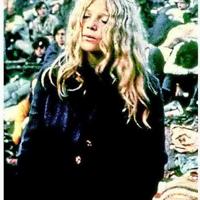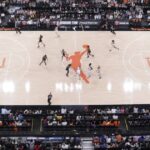No, that’s not a four-word summation of the early evolution of humans — or a chortle-accented quip from a vintage episode of MTV’s “Beavis and Butt-Head.”
But mud was inextricably a key ingredient at the rain-soaked 1969 and 1994 editions of the legendary Woodstock festival, which were held 55 and 30 years ago this month, respectively. And multiple fires were set by rioting attendees at the event’s violent third and final iteration on a late-July weekend in 1999.
Beyond the elements and their shared name of Woodstock, the three festivals are notable for the alternately dispensable and generation-defining music they presented, for the hundreds of thousands of young fans they attracted (many without tickets) and as gauges of both how long-lasting and how fickle pop culture can be.
People are also reading…
Billed as “three days of peace and music,” the exceedingly well-documented 1969 Woodstock was poorly organized and ineptly executed (a template, alas, for the two editions that followed). It had almost no infrastructure of any kind, became a muddy mess following torrential downpours and stretched to four days because of the lengthy rain delays.
But the nearly half-millionstrong audience and the performers — including Jimi Hendrix, Janis Joplin and the Who — rose above the elements, as was vividly documented in the Oscar-winning 1970 documentary film “Woodstock.” The mass communal spirit created during that weekend, fueled by a peace, love, “we-are-one” hippie ethos, became as legendary as the best music that was performed.
Not so in the case of the equally muddy and not quite as peaceful Woodstock ’94 — which this writer covered in its entirety — or the violence-riddled Woodstock ’99, which ended with looting, sexual assaults and multiple fires set by attendees.
“The first Woodstock in 1969 had a global impact. The other two had the same name, but they weren’t really Woodstock,” said Jocko Marcellino of Sha Na Na.
His band was the penultimate to perform at Woodstock, taking the stage immediately prior to Hendrix’s epic, festival-concluding performance. Under Marcellino’s leadership, Sha Na Na starred in its own syndicated hit weekly TV series from 1977 to 1981, was featured in the hit 1978 film “Grease” and toured and recorded until shortly before the pandemic shutdown in early 2020.
“By the time we got on stage at Woodstock, two days after we were scheduled to perform, it was such a mess that it looked like a refugee camp,” Marcellino, 74, recalled. “But it was life-changing, for us and for the world. It was a long, hard weekend where everyone had to cooperate with each other to get through it, and we did. That’s when ‘Woodstock Nation’ was born, but it got killed at (the violence-marred) Altamont (festival in December 1969), and then came disco in the ’70s.”
Blues Traveler guitarist Chan Kinchla was born in 1969, less than three months before Woodstock took place. He grew up listening to his parents’ copy of the “Woodstock” album and watched the documentary each time it aired on PBS.
“I was very aware of Woodstock as a pretty amazing musical and cultural experience, and it was always in my psyche,” said Kinchla, 55, whose band performed on the opening day of Woodstock’s 1994 edition.
“There was a lot more going on, culturally, in the 1960s,” he noted. “Unfortunately, the rain in 1994 and the riots in 1999 colored both of those festivals badly. … There weren’t any riots at the 1994 Woodstock, just a muddy free-for-all. But day one, before the rain came, was fantastic.”
Joan Baez was pregnant when she performed at the first Woodstock. She has mixed memories about the experience.
“It was a rare, historic moment, but it’s been over-glorified,” she recalled. “People say to me: ‘Oh, man, you played at Woodstock and you had everything — the music, the political scene, the community.’ And I tell them: ‘Yeah, we had the rain and the mud!'”
Regardless of the weather, the first Woodstock was a direct or indirect inspiration to countless outdoor music festivals that followed, including Lollapalooza, Coachella, Bonnaroo, Japan’s Fuji Rock, England’s Glastonbury, Brazil’s Rock in Rio and many more. The impact of the 1969 Woodstock has been thoroughly documented in multiple books, recordings and the Oscar winning documentary, whose crew included the then-little-known Martin Scorsese as an assistant director and film editor.
Seemingly everything that could go wrong did go wrong at the 1969 festival, where a majority of the estimated 400,000 to 500,000 attendees crashed the festival without tickets.
Doing so wasn’t difficult, since Woodstock’s hapless promoters never installed any fencing, gates or ticket turnstiles at the event, which was held on a grassy, 600acre dairy farm in Bethel, New York, owned by Max Yasgur. He volunteered his land only after the other sites the inexperienced young producers had chosen fell through after opposition from residents and local officials who did not welcome a mass hippie invasion.
For a young generation that embraced peace and love, Woodstock demonstrated that such egalitarian ideals could be achieved by a mass of people so large that Woodstock — if only for a weekend — became the second-largest city in the state of New York.
“Woodstock changed my life,” said guitarist Carlos Santana, whose band was one of the hits of the festival. “I was able to witness firsthand that a mass number of humans can coexist in harmony.”
Santana, 77, is still touring with his band, but he is an exception. A significant numbers of artists who performed at Woodstock in 1969 are deceased, and only a handful are still actively making music.
The contrast between the first festival and its final iteration in 1999 is so stark it merits a back-to-back comparison.
For the 1999 edition, the producers chose the site of the former Griffiss Air Force Base in Rome, New York. It had been home to a large contingent of the B-52 bombers used during the same Vietnam War many 1969 Woodstock attendees had protested against. The deactivated base was surrounded by a specially constructed 20-foot-high, steel-and wood-reinforced wall that stretched 3.5 miles.
The producers had it painted with bright murals that — without any apparent appreciation for irony — they dubbed the “Peace Wall.” Given the chaos and violence that transpired during the festival, “Hell Wall” may have been more appropriate.
“Our lesson from the previous (two) Woodstocks was to build a better fence,” Michael Lang, the sole Woodstock producer to be involved with all three festivals, said in a 1999 San Diego Union-Tribune interview. “The air base has a fence. But we added our own, and it’s beautiful. It’s the world’s longest mural, and it protects the integrity of the gates.”
On paper, the former air base appeared to offer some welcome assets. These included paved roads, plumbing, electricity, phone lines, parking for 60,000 cars, a 260-acre campground for festivalgoers and housing quarters for at least 8,000 of the festival’s 14,000 workers and some media members.
Alas, like at the first Woodstock in 1969, things went off the rails in a big way at the 1999 edition. The “love-one-another” spirit of mutual cooperation that pervaded at the original event 30 years earlier was in short supply, with or without a “Peace Wall.” Women attendees were groped. Multiple rapes were reported.
The sweltering heat reached triple digits. There was little shade. A lack of lawn areas meant some attendees had to pitch their tents on concrete. The 1.5-mile distance between the two main stages necessitated attendees hiking on tarmac that intensified the heat of the day.
The infrastructure broke down, and human effluent covered parts of the festival site. Food and drink vendors were allowed to charge as much as they wanted to the largely dehydrated audience.
Some bands, including Canada’s the Tragically Hip, had rocks and bottles thrown at them. Ditto Kid Rock, although he encouraged the audience to do so. Another act, nu-metal dunderheads Limp Bizkit, all but incited a riot when — just prior to performing their tantrum-filled song “Break Stuff” — the band’s vocalist, Fred Durst, encouraged the largely male audience to do exactly that.
Things got worse. Security guards abandoned their posts in droves. Candles handed out to the audience for an intended anti-gun-violence vigil during Red Hot Chili Peppers’ festival-concluding set quickly became tools for arson. As the band played the classic Hendrix song “Fire,” sound towers were set ablaze. So were some concession stands and overturned vehicles.
By subjecting attendees to often intolerable conditions, the festival’s producers at least indirectly set the stage for the violent debacle that ensued. And by booking acts like Limp Bizkit, whose lead singer encouraged the audience to “let yourself go, because there are no (expletive) rules out there,” they stoked the figurative and literal fires that followed.
By comparison, Woodstock ’94 was mostly a cakewalk — albeit a very muddy one — although by the time it ended the mood had darkened, and it became a small-scale harbinger of things to come at the 1999 festival.
Like its 1969 predecessor, Woodstock ’94 saw several hundred thousand fans enter without tickets. Unlike the debut edition, it boasted corporate sponsors, including Pepsi and Apple. The 1994 festival site in Saugerties, New York, was surrounded by 17 miles of 8-foot-high chain-link fences but few visible security guards. The event began under sunny skies that soon gave way to intense rain.
Some original Woodstock artists also performed at the 1994 edition, including Santana, Joe Cocker, the Band, Country Joe McDonald, John Sebastian and Crosby, Stills & Nash. But for the primarily 20-something audience, it was such then-young acts as Green Day and Nine Inch Nails who best captured the essence of the mud-caked event, which also featured everyone from Metallica and Melissa Etheridge to Cypress Hill and Sheryl Crow.
Disorganization prevailed offstage, just as at the poorly executed 1969 and 1999 editions of Woodstock. Garbage and sewage overflowed. Some high-priced food concession stands were stormed, and a shuttle bus was hijacked. Thankfully, the majority of the vast crowd retained an admirable degree of equanimity.
The morning after Woodstock ’94 concluded, the festival site looked like a war zone, whereas Woodstock ’99 actually turned into one. From peace and love in 1969 to chaos and riots in 1999, the legacy of this hailed and reviled festival is a muddled one. It will always remain so.





